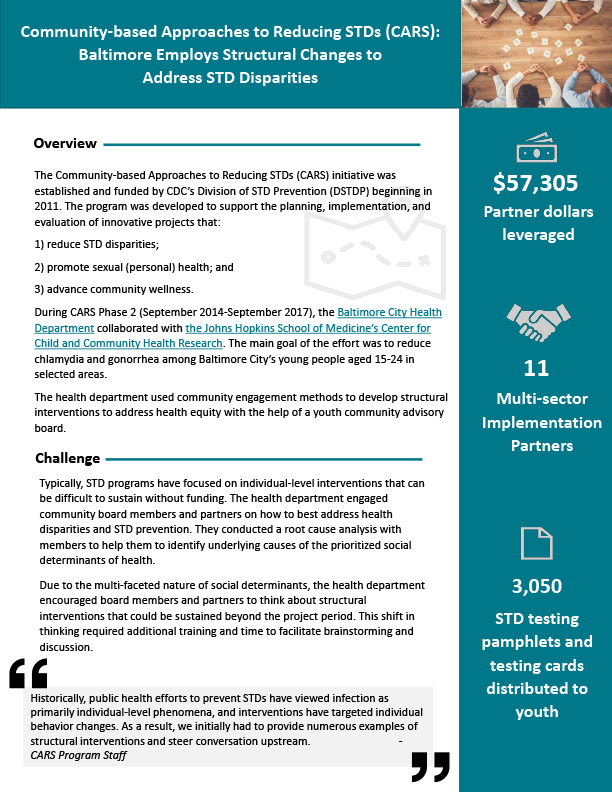Community-based Approaches to Reducing STDs (CARS):
Baltimore Employs Structural Changes
The Community-based Approaches to Reducing STDs (CARS) initiative was established and funded by CDC’s Division of STD Prevention (DSTDP) beginning in 2011. The program was developed to support the planning, implementation, and evaluation of innovative projects that:
- reduce STD disparities;
- promote sexual (personal) health; and
- advance community wellness.
During CARS Phase 2 (September 2014-September 2017), the Baltimore City Health Departmentexternal icon collaborated with the Johns Hopkins School of Medicine’s Center for Child and Community Health Researchexternal icon. The main goal of the effort was to reduce chlamydia and gonorrhea among Baltimore City’s young people aged 15-24 in selected areas.
The health department used community engagement methods to develop structural interventions to address health equity with the help of a youth community advisory board.

money icon
$57,305 Partner dollars leveraged
people arrows solid icon
11 Multi-sector Implementation Partners
paper icon
STD testing pamphlets and testing cards distributed to youth
Typically, STD programs have focused on individual-level interventions that can be difficult to sustain without funding. The health department engaged community board members and partners on how to best address health disparities and STD prevention. They conducted a root cause analysis with members to help them to identify underlying causes of the prioritized social determinants of health.
Due to the multi-faceted nature of social determinants, the health department encouraged board members and partners to think about structural interventions that could be sustained beyond the project period. This shift in thinking required additional training and time to facilitate brainstorming and discussion.

Historically, public health efforts to prevent STDs have viewed infection as primarily individual-level phenomena, and interventions have targeted individual behavior changes. As a result, we initially had to provide numerous examples of structural interventions and steer conversation upstream.
– CARS Program Staff

Addressing Challenges
Young board members identified the following three priority social determinants:
chalkboard teacher solid icon Lack of sexual health education
hand holding medical solid icon Lack of sexual health services
vials solid icon Negative culture/perceptions of STD testing
cogs icon
Advocating for structural changes positioned the health department to increase the likelihood of sustainability.
people icon
Addressing structural barriers required additional training and a different way of thinking among board members and partners. The root cause analysis (‘but why’ strategy) facilitation sessions aided in better understanding underlying causes of the priority social determinants.
bullseye pointer solid icon
Providing youth-friendly STD materials, developed by young board members shed light on the importance of obtaining community feedback on communication resources. Baltimore’s health department now has fresh, bright communication materials to help young clients feel more comfortable with and aware of the STD testing process.
In an effort to address the lack of sexual health services and negative culture of STD testing, the health department worked collaboratively with Johns Hopkins to develop and implement protocols for expanded community-based STD testing and improve the STD testing environment for clients.
Johns Hopkins contracted with the Maryland Institute College of Arts Center for Social Design to evaluate the structural changes and assist with the development and design of communication materials to address the negative culture of STD testing. As a result, 373 clients at the health department’s Eastern STD Clinic were surveyed to assess changes between the registration form type (original vs. redesign) and pre-and- post process “map” intervention implementation. Changes addressed the issues raised by clinic clients: lack of transparency and predictability of the STD testing process, long wait times, and anxiety.
The health department engaged 11 multi-sectoral partners to assist in the implementation of the CARS interventions. Partners provided in-kind resources such as supplies, staff time, training, and intervention implementation support.
The health department also worked with the community-based program, I Want The Kitexternal icon, to test 461 youth for chlamydia and gonorrhea in the community. Youth testing positive were effectively treated. Chlamydia positivity rates, including the no-cost extension year, were over 10 percent each year.
Year 2 – 10.2%
Year 3 – 12.1%
Year 3 – 12.1%
(no cost extension)
For more information about the CARS initiative, please visit https://www.cdc.gov/std/health-disparities/cars.htm
